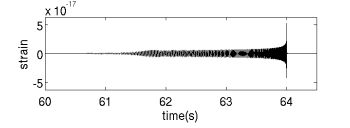When two neutron stars or black holes spiral inwards and coalesce, the gravitational waveform which is produced can be accurately modelled using mathematical approximations, or by evolving the system numerically on a computer. Similarly, we can predict the gravitational wave signal from a distorted neutron star. When the waveform shape is known, we can make use of this knowledge to assist our search for gravitational waves. To do this, we employ a technique called matched filtering — where we correlate the known signal against the detector output which contains both signal and noise.

As an example, consider the waveform shown above which is from a coalescing binary system. In the left hand figure below, this signal (shown in red) is buried in the noisy data. However, when we matched filter the data against a template signal of the same shape, there is a clear peak in the signal to noise ratio at the time of the signal as shown by the right hand figure.





